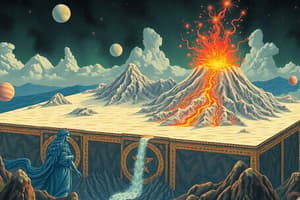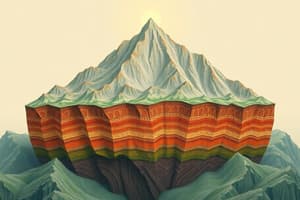Podcast
Questions and Answers
Qu'est-ce qui se forme lors des frontières divergentes?
Qu'est-ce qui se forme lors des frontières divergentes?
- Des zones de subduction
- Des failles transformantes
- De nouvelles croûtes océaniques (correct)
- Des montagnes
Les dorsales océaniques sont formées par la subduction des plaques tectoniques.
Les dorsales océaniques sont formées par la subduction des plaques tectoniques.
False (B)
Nommez un exemple de vallée de rift.
Nommez un exemple de vallée de rift.
Vallée du Rift Est-Africain
Les __________ sont des zones linéaires d'extension crustale qui conduisent souvent à la formation de nouveaux bassins océaniques.
Les __________ sont des zones linéaires d'extension crustale qui conduisent souvent à la formation de nouveaux bassins océaniques.
Associez les types de frontières tectoniques avec leurs effets géologiques:
Associez les types de frontières tectoniques avec leurs effets géologiques:
Quel phénomène est associé aux dorsales océaniques?
Quel phénomène est associé aux dorsales océaniques?
Le processus de rifting est principalement alimenté par la convection du manteau.
Le processus de rifting est principalement alimenté par la convection du manteau.
Quelle est la caractéristique géométrique des vallées de rift?
Quelle est la caractéristique géométrique des vallées de rift?
Flashcards
Tectonique des plaques
Tectonique des plaques
Une théorie expliquant la structure, le mouvement et les interactions de la lithosphère terrestre (couche externe). La lithosphère est divisée en plusieurs plaques rigides de différentes tailles qui se déplacent lentement sur l'asthénosphère (une couche visqueuse en dessous).
Limites des plaques
Limites des plaques
Les endroits où les plaques tectoniques interagissent, provoquant divers phénomènes géologiques.
Limites divergentes
Limites divergentes
Les plaques s'écartent, créant une nouvelle croûte.
Limites convergentes
Limites convergentes
Signup and view all the flashcards
Limites transformantes
Limites transformantes
Signup and view all the flashcards
Dorsales médio-océaniques
Dorsales médio-océaniques
Signup and view all the flashcards
Rifts
Rifts
Signup and view all the flashcards
Vallées du Rift
Vallées du Rift
Signup and view all the flashcards
Study Notes
Plate Tectonics and Reliefs
- Plate tectonics is a theory explaining the structure, movement, and interactions of Earth's lithosphere (outer layer).
- The lithosphere is divided into several large and small rigid plates that move slowly over the asthenosphere (a viscous layer beneath).
- Plate boundaries are where these plates interact, causing various geological phenomena.
- Three primary types of plate boundaries exist:
- Divergent boundaries: Plates move apart, creating new crust.
- Convergent boundaries: Plates collide, resulting in mountain ranges, volcanoes, and/or subduction zones.
- Transform boundaries: Plates slide past each other horizontally, causing earthquakes.
- Types of relief are directly related to plate boundary types.
- Divergent boundaries often create rift valleys and mid-ocean ridges.
- Convergent boundaries can result in mountain ranges (e.g., the Himalayas) or volcanic arcs.
- Transform boundaries are associated with major fault lines, such as the San Andreas Fault, and significant seismic activity.
Mid-Ocean Ridges
- Mid-ocean ridges are underwater mountain ranges formed by seafloor spreading at divergent plate boundaries.
- Magma rises from the asthenosphere, cools, and forms new oceanic crust.
- This process creates a ridge, where new crust pushes older crust outward.
- The spreading rate impacts the ridge's morphology, with faster spreading rates leading to broader ridges.
- These ridges are often characterized by hydrothermal vents, which release hot mineral-rich water into the ocean.
- The characteristics and location of these vents impact the unique ecosystems that flourish around them.
Rifts
- Rifts are linear zones of crustal extension that often form the initial stages of ocean basin formation.
- These zones are characterized by faulting and volcanism.
- Rifting is the process of the lithosphere pulling apart, leading to the creation of a rift valley.
- Continental rifts are elongated depressions formed as continental crust is stretched and thinned.
- As rifting progresses, it can eventually lead to the separation of continents and the formation of new ocean basins.
- Rift valleys exhibit a characteristic geometry with steep slopes and a central graben (a down-dropped block).
- An example of a rift valley is the East African Rift Valley.
- Rifting is primarily driven by mantle convection, although the exact mechanisms are complex and still being researched.
- The processes result in distinctive geological features and ongoing seismic activity along the rift.
Studying That Suits You
Use AI to generate personalized quizzes and flashcards to suit your learning preferences.




